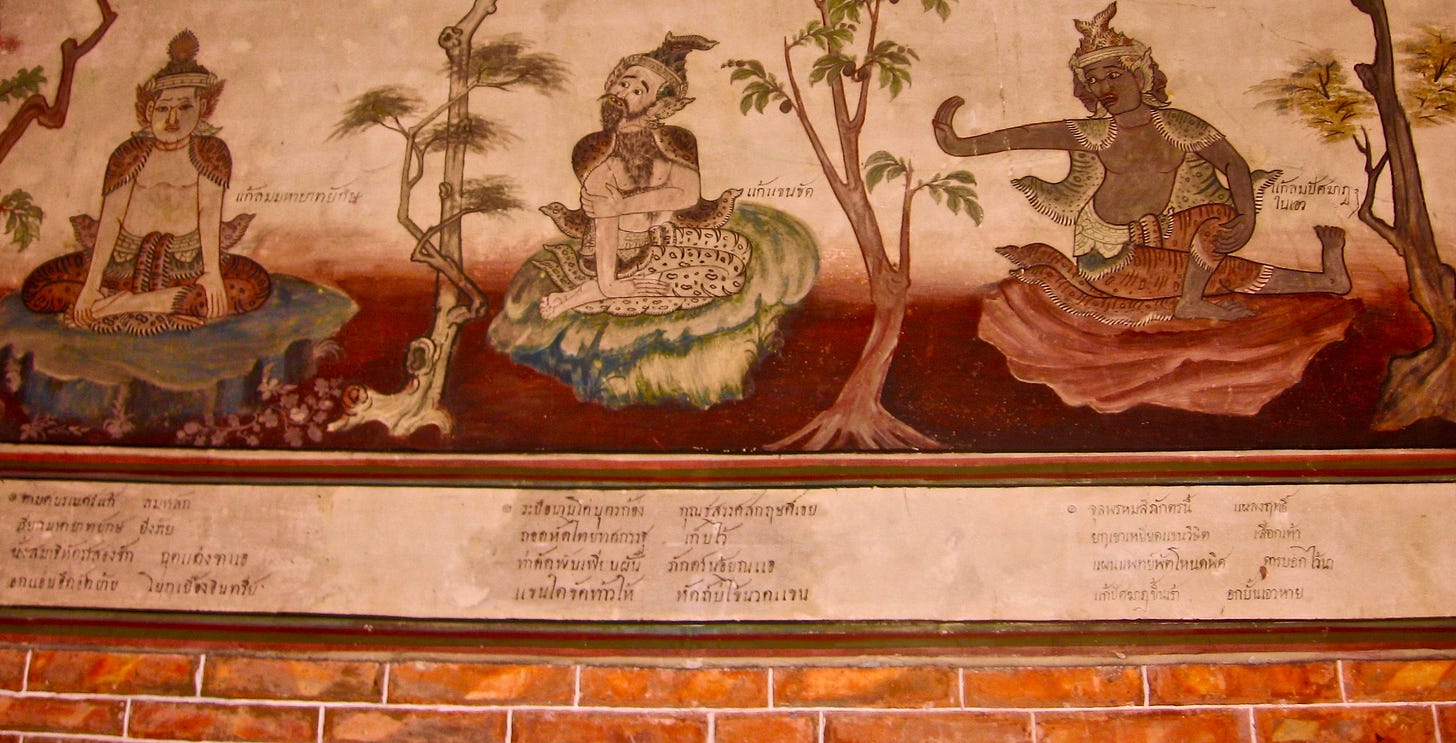For well over 2000 years, mainland Southeast Asia has been at the crossroads of vast systems of trade between India, East Asia, and the islands around Southeast Asia itself. There is evidence from 300 BC of contact with India. Many aspects of Indian culture — including language, law, political theory, science, medicine, art, dance, literature, mythology, religion, tantra, and yoga — were adopted by Southeast peoples, giving rise to unique hybrid combinations of Indian and indigenous cultures. Artists created monuments and artwork drawing upon Indian ideas with forms and styles unique to Southeast Asia. Gods, goddesses, apsaras, demons, and buddhas can all be see. There are also numerous images of yogis known as rishi in India, tusi in Vietnam, eysey in Cambodia, risi in Laos and reusi in Thailand.
I first traveled to Southeast Asia in 1990 to serve as a Peace Corps volunteer in Thailand. While studying Traditional Thai Massage or Nuad Boran at Wat Po Temple in Bangkok, I saw the Reusi Dat Ton (Traditional Thai Yoga) statues on the two Rishis’ Mountains on the temple grounds and became fascinated with this practice. I have now been a student of Thai Reusi Dat Ton and Indian Hatha Yoga for over 30 years.
During that time, I have traveled throughout Thailand, mainland Southeast Asia, and South Asia researching and studying yoga with dozens of teachers at various temples, ashrams, schools and institutes. In addition, I have visited numerous universities, libraries, museums, temples, caves and ancient archaeological sites on a quest for historical evidence of yoga poses in traditional texts, iconography, and artwork across Southeast Asia. In this article, I will share with you the best of what I have discovered.
Early Yoga Poses in SEA Art & Architecture
The earliest artistic depiction of a yoga pose I have found to date is at Sambor Prei Kuk in Kampong Thom, Cambodia, dated to about 600 AD. Sambor Prei Kuk was a capital city of the pre-Angkorian Chenla Empire and is one of the oldest surviving temple complexes in Cambodia. On an outside wall of the Yogi’s Tower or Prasat Asram in Sambor Prei Kuk, one can still discern a yogi in what is known in India as sopāśrayāsana pose, i.e., squatting while tying the back and the two legs with a piece of cloth. I found similar figures at Yasodharapura, an early capital of the Khmer Empire, in Roluos, Cambodia. Here, yogis in sopāśrayāsana pose can also be seen on the outside walls of the Lolei Temple, dated to about 893.
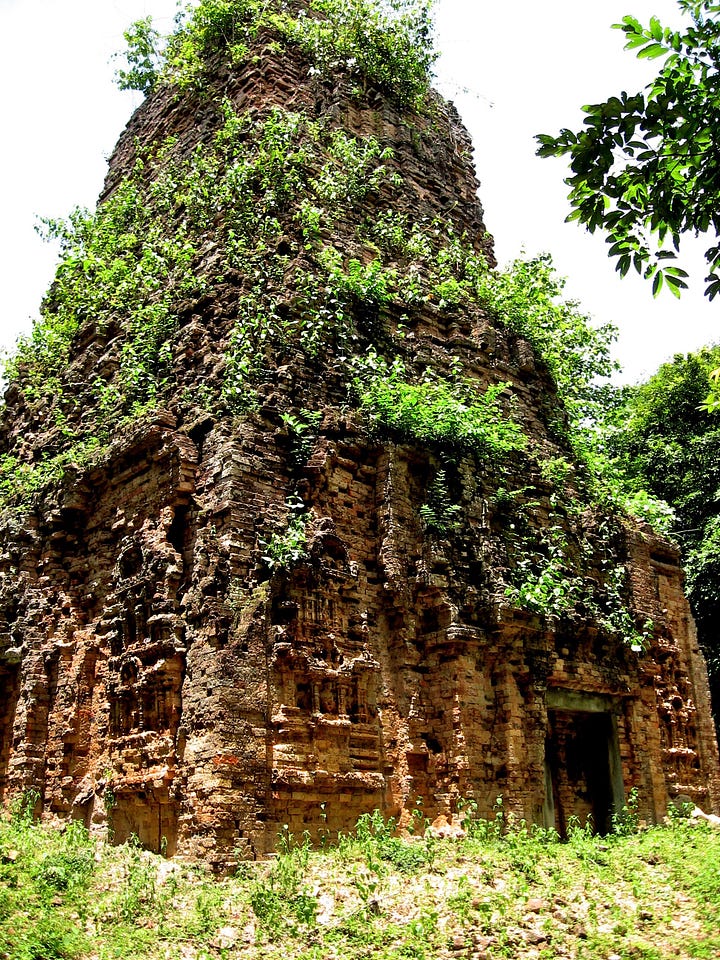


During my journeys across Southeast Asia, I have found images of yogis and gods in various yoga poses carved into stone at several ancient temples dedicated to Siva. In Southern Laos, in Champasak Province at the base of Lingaparvata Mountain, is the vast Vat Phu temple complex, dated to about 500-1100. Also known as the “Mountain Temple,” Vat Phu has traditionally been a special site for asceticism since ancient times. It was originally occupied by the Chams, then the Chenla and finally the Khmer who all continued the traditional worship of Siva at the site (Albanese p 283).
Outside and behind the central shrine carved into a rock face at the base of a cliff are the three gods of the Hindu trimurti, one of whom is performing a seated twisting pose similar to techniques practiced today in Reusi Dat Ton. In addition, numerous yogis in squatting poses, including sopāśrayāsana, are carved into stone on the base colonettes of doorways of numerous buildings throughout the Vat Phu temple complex.
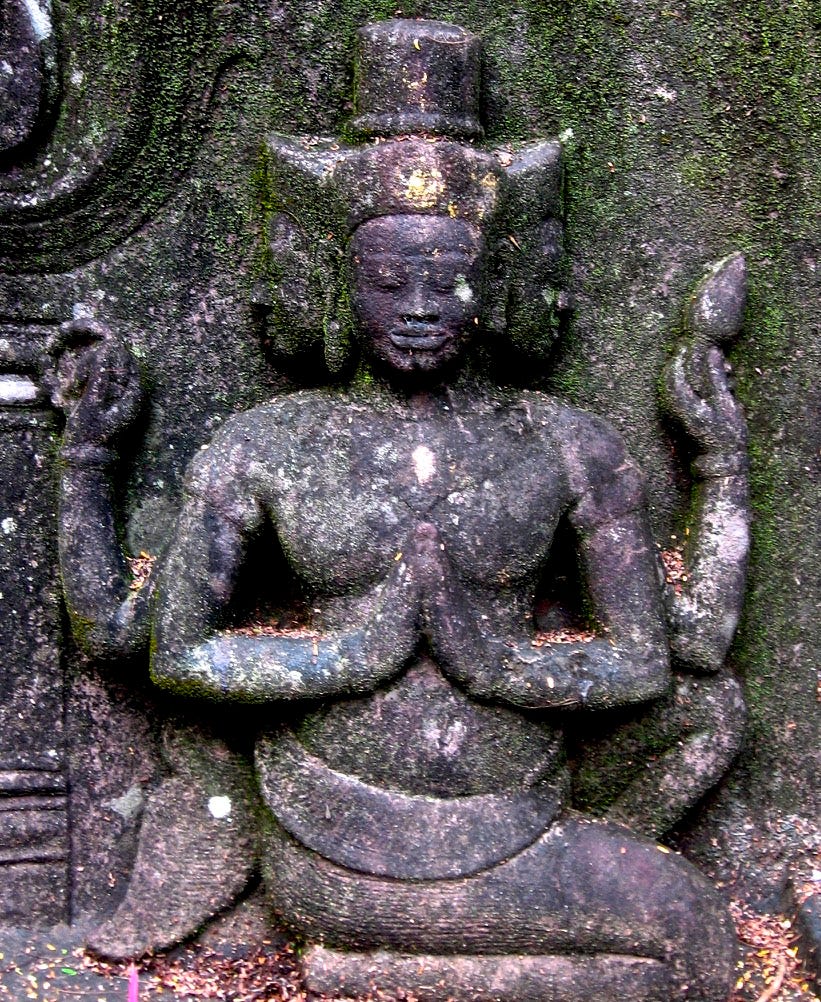
In Northeast Thailand, in Buriram Province, atop an extinct volcano sits Prasat Phanom Rung “Big Mountain Temple,” constructed around 1100. Prasat Phanom Rung is a classical Khmer Temple that represents Siva’s home on Mount Kailasa. The temple is dedicated to the Pasupata sect of Hinduism and its concept of “formless yoga” (Srisuchat, 148). At base of the Principal Tower at Prasat Phanom Rung, carved into two stone colonettes at the bases of doorways are images of yogis practicing poses including utkutikasana, “the tight squatting pose” (Srisuchat, 154). These poses are also similar to techniques still practiced today in Thai Reusi Dat Ton.

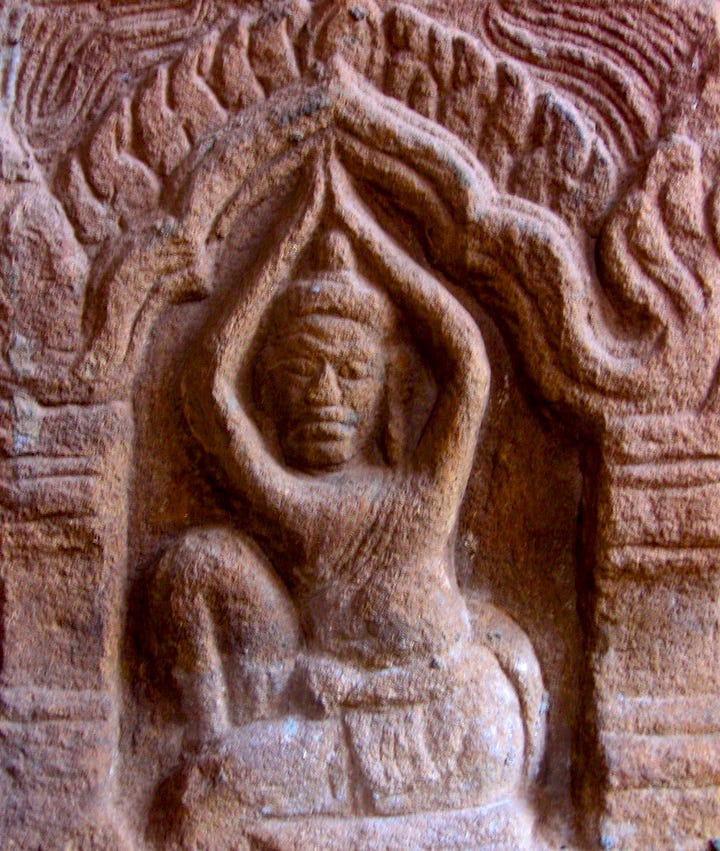
Last but not least, I include a statue from Vietnam. While I found this one in a museum, not a temple, it’s one of my favorite early images of yogic postures because of how well it is preserved. The Museum of Cham Sculpture in Danang, Vietnam, houses a fabulous collection of stone sculptures recovered from various ancient Cham archaeological sites in southern and central Vietnam. One of the highlights of the museums collection is a sculpture of an apsara, a mythological celestial dancer in the “graceful three-bends posture (tribhanga)” (Museum of Cham Sculpture in Danang, Vietnam). This pose is nearly identical to a technique in Reusi Dat Ton known as “Gazing at the Stars.” This statue, dated around 1000, was originally from Tra Kieu, Simhapura, the first capital of the Hindu Cham Kingdom.

Nineteenth Century Examples
While the earliest artistic depictions of yoga techniques I was able to find in mainland Southeast Asia are primarily squatting, in later centuries, there appear a increasing number of more complex poses. This trend culminates in the 19th century with a sudden and vast proliferation in the sculpture and murals depicting yogic poses and exercises closely related to the Thai practice of Ruesi Dat Ton. In this section, I will give you some of my favorite examples from this era.
Advanced yoga practitioners are said to be able to develop various supernatural powers known as siddhi in Sanskrit and iddhi in Pāli. Among these powers are laghima, the ability to become weightless and fly. An example of artwork depicting this can be seen in Siam Reap, Cambodia, at the Buddhist Temple, Wat Bo. Inside the central shrine room high up on the inside walls are murals painted approximately 1800, depicting scenes from the Indian epic the Ramayana, known in Cambodia as the Reamker. One scene depicts four Yogis flying thru the sky. The abbot of the temple told me that the pose these Yogis are using is a special pose specifically used for flying. Indeed, during my travels throughout South and Southeast Asia, when I saw flying beings depicted in traditional artwork, they were almost invariably in an identical or very similar pose. This pose also appears in Ruesi Dat Ton practice.
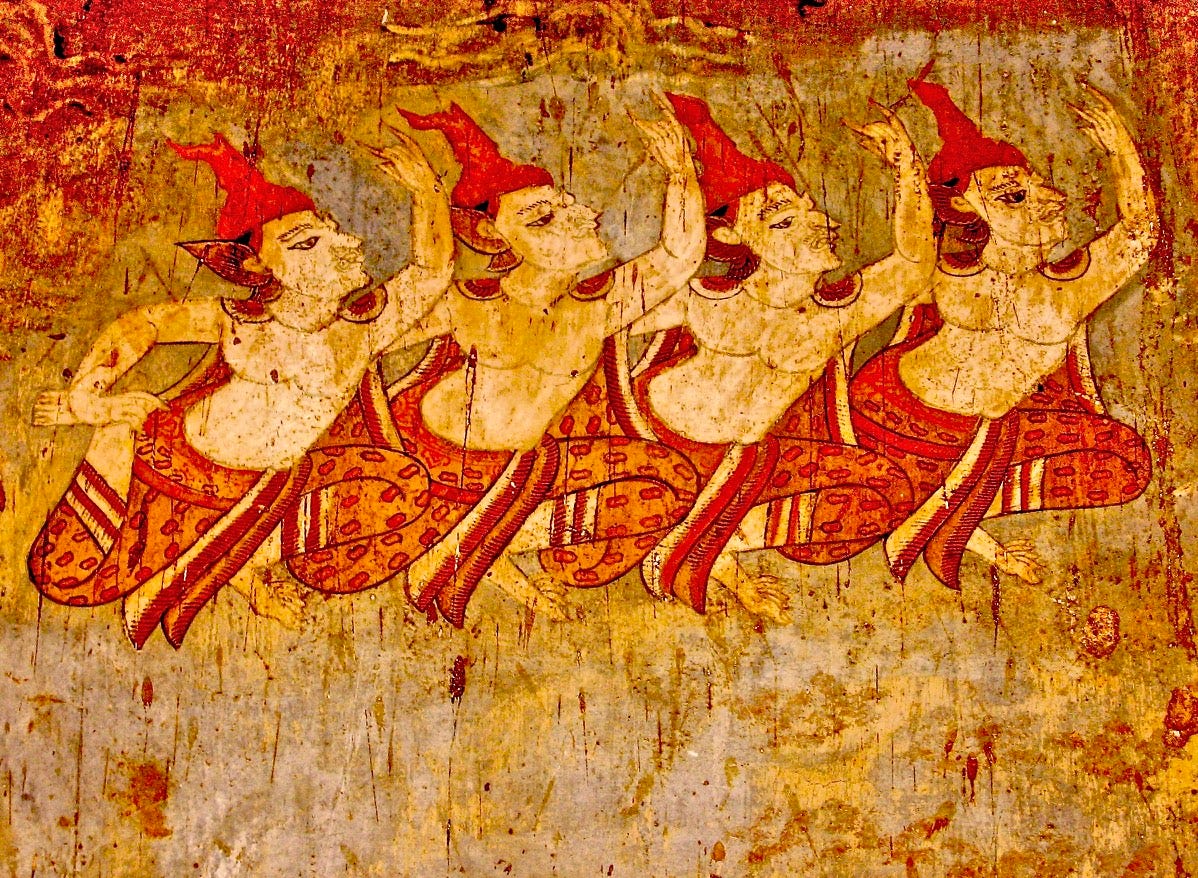
In 1836, the Thai king Rama III commissioned the creation of 80 statues depicting some of the techniques of Reusi Dat Ton. About 20 of the original statues have survived and can be seen on the two Hermit’s Mountains or Khao Mor, at Wat Phra Chetupon (“Wat Po”) in Bangkok. Inscriptions describe the statues as “postures of yogic exercise invented by siddhas for remedy of illness… due to the malfunctioning of internal air or wind” (Srisuchat, 172). Along with each statue, there was also an accompanying tablet upon which was etched a poem describing the technique and its therapeutic effect.

In the Southern Thai provincial capital of Songkhla, there is a temple known as Wat Machimawat. On the temple grounds is the Reusi Dat Ton Pavilion, Sala Reusi Dat Ton. High up on the inside walls of the pavilion are two murals originally painted in 1863, depicting 40 different Reusi Dat Ton techniques along with the accompanying poems that describe the therapeutic benefit of each technique. I had seen photos of this mural in an old book in the National Library in Bangkok. In the book, the mural looked to be considerably damaged and many of the images were fading. When I arrived at the temple, the abbot informed me that my timing was excellent as just the week before a team from the Thai Fine Arts Department had finished repairing and touching up sections of the murals. I was able to borrow a ladder and spent the next day photographing the two newly restored Reusi Dat Don murals.

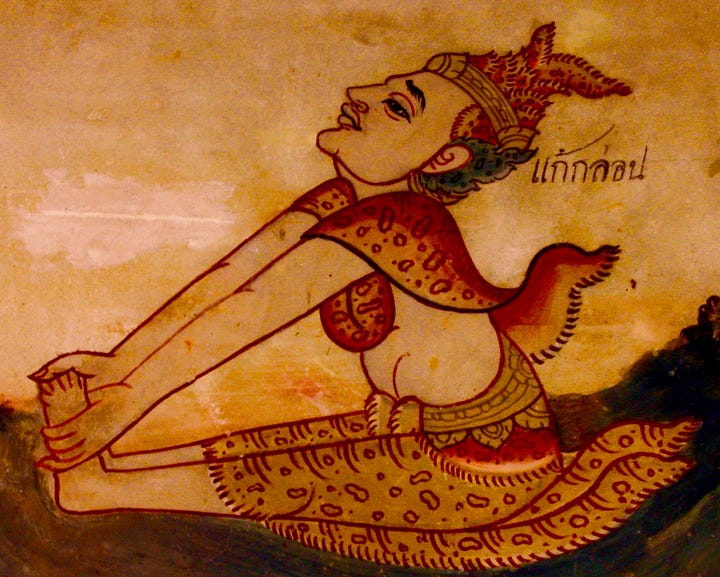
In Reusi Dat Ton, there is a series of six poses based upon the temple guardians, known as yakshas. One of these poses, known as the “Giant Holding up the Roof” can be seen at the base of the Phra Suvarnachedi tower on the grounds of the Temple of the Emerald Buddha, Wat Phra Kaew, in Bangkok, Thailand. The temple was constructed circa 1783 and the guardian giants were added sometime during the Reign of King Rama V (1868-1919) A similar pose is also found in Indian Hatha Yoga where it is known as “the Goddess.”

References and Further Reading
Albanese, Marilia (Author,) A.B.A.-Milan (Translation.) 2006. Angkor, Splendors of The Khmer Civilization. Bangkok: Asia Books.
Bassoul, Aziz. 2006. Human and Divine: The Hindu and Buddhist Iconography of Southeast Asian Art from the Claire and Aziz Bassoul Collection. Beirut: Cedar of Lebanon Editions Publisher.
Bunker, Emma C. 2003. Tantric Hinduism in Khmer Culture. Asian Department, Denver Art Museum. Published in www.asianart.com/articles/bunker/index.html.
Chandler David P. 1983. A History of Cambodia. Boulder: Westview Press.
Conti, Pia Tantric Buddhism in Phimai: A New Reading of its Iconographic Message. https://angkordatabase.asia/publications/tantric-buddhism-in-phimai-a-new-reading-of-its-iconographic-message.
Griswold, A.B. 1965. The Rishis of Wat Po. In Felicitation Volumes of Southeast Asian Studies. Presented to His Highness Prince Dhaninivat Kromamun Bidyalabh Brindhyakorn. Bangkok: Siam Society.
Matics, Kathleen Isabelle. 1978. An Historical Analysis of the Fine Arts at Wat Phra Chetuphon: A Repository of Ratanakosin Artistic Heritage, PhD Dissertation, New York University, New York.
Matics, K.I. 1977. Medical Arts at Wat Pha Chetuphon: Various Rishi Statues. Journal of the Siam Society, 65:2: 2: 145-152.
Museum of Cham Sculpture, Visitor Information Display at The Museum of Cham Sculpture in Danang, Vietnam.
Powell, Seth. 2018. The Ancient Yoga Strap: A Brief History Of The Yogapatta. Published in TheLuminescent.blogspot.com16 June 2018 (v2).
Srisuchat, Amara. 2004. Yoga Philosophy in Secondary Thought: Tracing Back to Yoga in Thailand’s Past. PhD Dissertation, Department of Oriental Languages, Silpakorn University, Bangkok.
Suebsantiwongse, Saran. 2023. The Thai Body: Understanding the Principles of Medicine, Physiology, and the Massage Tradition through Inscriptions, Texts, and the Material Culture of Wat Phō. in Part 4 of The Rutledge Handbook of Religion and the Body. Edited by Yudit Kornberg Greenberg and George Pati. London: Taylor & Francis Publishing.
Trà̂n, Kỳ Phương, Văn Thắng Võ and Peter D. Sharrock. 2018. Vibrancy in Stone: Masterpieces of the Đà Nẵng Museum of Cham Sculpture. New York: River Books.
Wells, David. 2012. “Reusi Dat Ton: The Thai Hermit’s Exercises” Yoga Mimamsa, Volume 44, No. 1: 1-18.
Wells, David. 2016. Self-Massage and Joint Mobilization of Traditional Thai Yoga: Reusi Dat Ton Part 1 Handbook. North Charleston: CreateSpace Independent Publishing Platform.
David Wells, E-RYT500, YACEP, C-IAYT, CAS, works as a yoga therapist in an interdisciplinary pain management clinic and conducts continuing education workshops for yoga teachers, yoga therapists, and massage therapists. He received advanced yoga certifications from the Kaivalyadhama Yoga Institute, the Sivananda Yoga Center, and the Yoga Institute in Mumbai in India. He served three years in Peace Corps Thailand and received Thai Massage and Reusi Dat Ton certifications from the Wat Po School of Thai Traditional Medicine and the Thai Ministry of Education. He also studied with Reusi Tevijjo and the late Ajhan Pisit Benjamongkonwaree in Thailand. He is also a graduate of the California College of Ayurveda. Contact: david@wellsyoga.com and www.wellsyoga.com.

